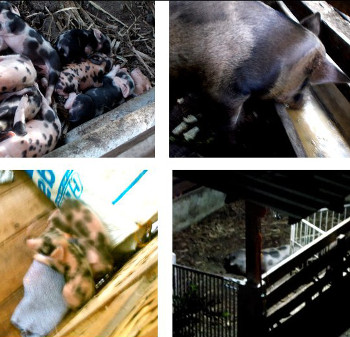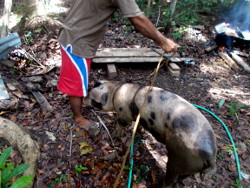
Brownie's Fourth Farrowing
The History:
-9 August 2019



The Two "Rescued" Piglets
Seem to be Thriving

Fatima builds a Temporary Pen on the
Balcony for the Two Piglets


Piglets Four Weeks Old Tonight

Balcony Piglets Escape -but are
recaptured

The Two "Orphaned" Balcony Piglets
Return to their Original Pen

...but are not Welcomed by the
Siblings

So they get Special Treatment (again)

The First Bunch of Piglets get taken to
New Homes

With only Four of the Eight Piglets Left -we
try to integrate the "Orphans" again

....but They Still get Bullied

Another Piglet Collected while We were
Out Shopping -Leaving just Three Behind

Plus the Two "Orphans"

The Last two Piglets are Collected
-together with some Cuttings and our Billy Goat

Leaving the "Orphans" to Inherit
the Pen



Piglet Moved to Temporary Pen Under
House
-Attempts to lure piglet
into a sack fail -so tied to a leash

-and finally lured with food into new
pen


Brownie's Pen is Tidied Up and No. One
Moves In


No.One Moved To A Temporary Pen

No.One Is a Bit Under the Weather -so
she gets a Bath to Cheer her up

No.One is Put in the Garden To Cheer
Her Up

No.One Has a Fever and is Given
a Bath -She is eating and drinking very little

No.One Starts Vomiting Blood and is
Put Back in Her Pen

August 09, 2019
The Problem:

Although Bohol is a promoted as a rural area strong in "Organic" farming, there is surprisingly little effective veterinary help for backyard farmer.
Without a reliable diagnosis, the backyard pig farmer is left to fend for themselves -and rely on their own experience and judgement.
In practice, this means that faced with a sick animal one has three choices:
For us, the problem was made more complicated because our new freezer had recently broken down and had not been repaired, due to a dispute with the retailer over the warranty.
- Cull the animal immediately -while the meat is still edible
- Wait -and hope the animal recovers naturally
- Give anti-biotic and hope the animal recovers -because the meat is otherwise inedible
Because profit margins are thin and most farmers cannot easily afford to write off their investment -this is a difficult choice to make, especially without expert help and good diagnostic backup.
The Preparation:
No.One was still poorly today -so we decided it was time to act.
The Butcher is very skilled -and the animals die quickly and silently
Currently weighing around 60 kilo, she had lost a lot of weight in the last few days
The Examination:
The meat seemed fit to eat -so we continued butchering.
The Carcass:
The Reading of the Entrails:
The Internal Organs, particularly the Stomach showed various signs of disorder.
The liver looked normal, but the Gall Bladder was black; the lungs were mottled, the intestines lumpy and distorted.
There were also blood clots in the intestines.
The stomach was black inside and contained remains of food from several days ago.
The blood seemed thin.
We suspect a stomach ulcer -but the cause?
The (Partial) Burial:

The End:

The Considered Diagnosis:
No.One (a 6-month old fattener)
After researching on the the Internet, Fatima came to the following conclusions:
Ruling Out Infectious Diseases
No.One had no diarrhea, no signs of skin discoloration, no eye or nose discharge, and no coughing. These rule out swine dysentery, ASF, classical swine fever and salmonellosis. She was an otherwise very healthy growing pig and by five to six months of age showed variable appetite despite rapidly gaining weight. On the second and third day of inappetance, she had lightly elevated temperature, but not high fever. On these days, she could only eat and drink very little. On the third day, she vomitted clotted blood and respiration rates increased for several hours due to raised temperatures. There was no further vomitting on the fourth day and body temperature was low. She defecated very little. Feces were dry, round and dark. Weight loss has started to become apparent. No.One weighed 63kg at slaughter on the fourth day.
Diagnosis - Gastric Ulcer or Ulceration of the Pars Oesophagea (UPE)
Having ruled out infectious diseases (but not ruling out possible H. suis infection), we conclude that No.One had Gastric Ulcer/UPE. On the third and fourth day, she must have had considerable (but not fatal) loss of blood as she was reluctant to stand up, seemed weak, and her gums, snout and vulva were white and not pink. At slaughter, inspection of the stomach showed large eroded areas of the pars esophagea and partially digested blood in both the pars esophagea and distal parts of the stomach. The pars oesophagea is normally pearly white. In No.One's case, an advanced degree of erosion and sloughing was seen.
The meat and carcass were pale. Inappetance and inability to drink could be due to stricture of the terminal esophagus or pars esophagea because of chronic ulcer. There were blood and blood clots in the stomach and in the intestines. The intestinal and colonic contents were very dark. There were signs of constipation at slaughter. If we waited a couple more days to slaughter, we would've seen blood in the stools (melena), and a dead anemic pig.
"Numerous studies have been conducted at slaughter and typically 80 or 90% of hogs show some type of lesion in the pars esophageal region. The thickening of the surface (parakeratosis) is very common and generally considered to be insignificant as far as its effect on the pigs health. However, erosions that sometimes involve the entire pars esophagea are found in up to 20 to 25% of stomachs at slaughter and these lesions are significant. On farms with good disease control, gastric ulcers are commonly the most important cause of mortality." - Gastric Ulcers, Pork Gateway Factsheet, 2012
Ruling out Hemorraghic Bowel Syndrome (HBS) and acute hemorrhagic PPE (Ileitis)
Histopathology, immunohistochemistry (IHC), or agent detection methods are required to confirm PPE. Nonetheless, we have ruled out HBS or PPE because HBS often strikes as sudden death without obvious symptoms while PPE symptoms typically include bloody stools, weight loss and diminishing growth. Pigs affected with HBS are often in good body condition and usually are found dead near feeder, very pale and with a distended abdomen. No.One was in good body condition but showed signs of illness and no signs of bloody thin-walled intestines at slaughter.
Could the Gastric Ulcer be secondary to other health issues?
Several common diseases can cause bleeding into the intestine, but generally these conditions are associated with diarrhea while gastric ulceration is not. However, at slaughter, No.One's lungs showed signs of early lesions and a certain degree of pleurisy was noted. This lung lesions correspond to interstitial pneumonia. The lungs are not collapsed and there is a multifocal to diffuse, lobular pattern of reddening.
Although there have been no clear clinical signs of lung disease such as pneumonia, it is possible that No.One had Porcine Parvovirus (PPV) or Porcine Reproductive and Respiratory Syndrome (PRRS). PPV affected sow No.Three in 2017 so PPV may have been present. PRRS affects all kind of farms, including high or low health status farms, extensive or intensive production systems; any size. In the past months, No.One showed very moderate coughing and sneezing which may already be symptoms of PPV/PRRS or possibly pleuropneumonia.
(Note: Sow Number 3 died of acute respiratory disease 13 days after No.One was slaughtered. We suspect she was infected by No.One).
Possible infectious component
The most important infectious component of porcine gastric ulceration is Helicobacter suis (H. suis). H. suis colonises the stomach of the majority of pigs as well as a minority of humans worldwide. It is present in saliva and in feces of infected pigs. An infection with H. suis may result in the excessive secretion of gastric acid. Humans occasionally acquire the infection, most likely through direct contact with pigs or consumption of contaminated meat. Normal hygienic precautions may reduce the possibility of infection. H. suis is a very fastidious microorganism making it very difficult to isolate. (Other gastric non-H. pylori helicobacters colonizing the human stomach are H. felis, H. salomonis, H. bizzozeronii, and the still-uncultivable “Candidatus Helicobacter heilmannii.” These microorganisms are often detected in the stomachs of dogs and cats.)
No.One's health status
No.One was laid over by the sow and rescued at the age of 2 days. She was fed sow milk substitute. She would've had little colostrum intake, and would not have the health benefits of mother's milk.
Note that No.One began showing signs of inappetance within a week of switching from Grower to Finisher feeds at the same time she was transferred to a smaller pen and drastic changes in weather (seasonal changes). Stress (due to changes in the environment) and diet particle size are known contributing factors to Gastric Ulcer.
Treatment and Prevention
(From - Gastric Ulcers, Pork Gateway Factsheet, 2012)
Pigs that are observed to be pale and weak should be segregated from pen mates to prevent bullying and severely anemic pigs should be euthanized. Individual animal treatment with pharmaceuticals is prohibitively expensive therefore rarely used, but could be employed in the case of a valuable breeding animal. The most practical approach to help a pale weak pig to regain health is to encourage the affected animal to eat. Mass medication with sodium bicarbonate or buffering agents have been used but with mixed results at best.
If a specific risk factor can be identified as the probable cause of an outbreak, then steps to correct the problem should be taken. For example, if hot weather is causing pigs to not eat, methods to cool the pigs should be explored. If the underlying problem appears to be respiratory disease, vaccination or medication might indirectly improve the prevalence of ulcers.
On Meat Quality
Meat is considered PSE (Pale, Soft and Exudative) and has inferior taste and odor, but showed no visible signs of disease or lesions. Because No.One has been sick and stressed before slaughter, there has been considerable breakdown of muscle glycogen and the meat becoming very pale with pronounced acidity (pH values of 5.4-5.6) and poor flavour. This type of meat is difficult to use or cannot be used at all by butchers or meat processors and is wasted in extreme cases.
The energy required for muscle activity in the live animal is obtained from sugars (glycogen) in the muscle. In the healthy and well-rested animal, the glycogen content of the muscle is high. After the animal has been slaughtered, the glycogen in the muscle is converted into lactic acid, and the muscle and carcass becomes firm (rigor mortis). This lactic acid is necessary to produce meat, which is tasteful and tender, of good keeping quality and good colour. If the animal is stressed before and during slaughter, the glycogen is used up, and the lactic acid level that develops in the meat after slaughter is reduced. This will have serious adverse effects on meat quality. (From CHAPTER 2: Effects of stress and injury on meat and by-product quality, Guidelines for Humane Handling, Transport and Slaughter of Livestock)
References:
Gastric Ulcers
<http://porkgateway.org/resource/gastric-ulcers/>
Ulceration of the Pars Oesophagea (Gastric Ulcers; Ulcers)
<https://vetmed.iastate.edu/vdpam/FSVD/swine/index-diseases/gastric-ulcers>
Gastric (Stomach) Ulcers
<https://www.pigprogress.net/Health/Health-Tool/diseases/Gastric-ulcers/>
Gastric Ulcers
<https://thepigsite.com/disease-guide/gastric-ulcers>
Guidelines for Humane Handling, Transport and Slaughter of Livestock
<http://www.fao.org/3/X6909E/x6909e00.htm>
Manual on meat inspection for developing countries
<http://www.fao.org/3/t0756e/T0756E00.htm>
